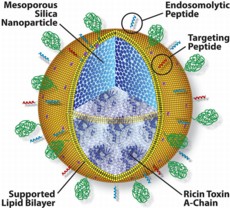Home > Press > Protocells – A Versatile Drug Delivery Platform
 |
Abstract:
Imagine it would be possible to transport drugs by a shuttle which would be drawn to the desired destination as if by magic on an invisible thread. Upon arrival, a gate is opened by a specific key and the vehicle can get rid of its precious cargo. This kind of targeted drug delivery would enable controlled and specific enrichment of a therapeutic agent in the tissue or organ where it is actually needed and side effects could be reduced.
Protocells – A Versatile Drug Delivery Platform
Germany | Posted on September 13th, 2012In traditional drug delivery approaches, only a small amount of the drug reaches the part of the body where it is actually required. It is therefore of the utmost importance to better predict and influence the degree of specificity in targeted drug delivery concepts.
The clinical use of protein toxins like Ricin toxin as anti-cancer agents is often hindered by their immunogenicity which leads to a dosage restriction and represents a significant drawback for their clinical utility. To exploit the valuable features of this class of therapeutic agents, smart and innovative hybrid architectures have to be designed which elegantly circumvent these limitations and fulfill the requirements expected of modern therapeutic agents.
Researchers from the University of New Mexico and from the Sandia National Laboratories present a highly complex system as a versatile delivery platform that may enable protein toxin-based therapies to reach their full potential. The so-called "Protocell" combines a mesoporous silica core loaded with the toxic RTA (Ricin toxin A) with the features of liposomes. The particle core is coated with a lipid bilayer further modified with a targeting peptid for specific delivery, and an endosomolytical peptide for intracellular release.
RTA-loaded protocells show a 500-fold higher capacity for RTA than conventionally loaded liposomes and are stable under neutral pH conditions, unlike the uncoated loaded silica particles or the liposomes which rapidly lose their encapsulated RTA under neutral pH conditions. However, under a slightly acidic pH which reflects the physiological conditions in the endosomal orlysosomal pathway, the total amount of cargo is released within 24 hours.
Due to the coexistence of the endosomolytical and the targeting peptide, only the receptor-positive cells are specifically addressed and killed whereas the viability of other cells is maintained.
Thus, in terms of capacity, stability, and triggered release, these kinds of protocells represent a substantial improvement over conventionally produced liposomes and have the potential to address many limitations of state-of-the-art toxin-based therapies.
####
For more information, please click here
Copyright © Wiley-VCH Materials Science Journals
If you have a comment, please Contact us.Issuers of news releases, not 7th Wave, Inc. or Nanotechnology Now, are solely responsible for the accuracy of the content.
| Related Links |
![]() Link to the original paper on Wiley Online Library:
Link to the original paper on Wiley Online Library:
| Related News Press |
News and information
![]() Simulating magnetization in a Heisenberg quantum spin chain April 5th, 2024
Simulating magnetization in a Heisenberg quantum spin chain April 5th, 2024
![]() NRL charters Navy’s quantum inertial navigation path to reduce drift April 5th, 2024
NRL charters Navy’s quantum inertial navigation path to reduce drift April 5th, 2024
![]() Discovery points path to flash-like memory for storing qubits: Rice find could hasten development of nonvolatile quantum memory April 5th, 2024
Discovery points path to flash-like memory for storing qubits: Rice find could hasten development of nonvolatile quantum memory April 5th, 2024
Nanomedicine
![]() New micromaterial releases nanoparticles that selectively destroy cancer cells April 5th, 2024
New micromaterial releases nanoparticles that selectively destroy cancer cells April 5th, 2024
![]() Good as gold - improving infectious disease testing with gold nanoparticles April 5th, 2024
Good as gold - improving infectious disease testing with gold nanoparticles April 5th, 2024
![]() Researchers develop artificial building blocks of life March 8th, 2024
Researchers develop artificial building blocks of life March 8th, 2024
Discoveries
![]() Chemical reactions can scramble quantum information as well as black holes April 5th, 2024
Chemical reactions can scramble quantum information as well as black holes April 5th, 2024
![]() New micromaterial releases nanoparticles that selectively destroy cancer cells April 5th, 2024
New micromaterial releases nanoparticles that selectively destroy cancer cells April 5th, 2024
![]() Utilizing palladium for addressing contact issues of buried oxide thin film transistors April 5th, 2024
Utilizing palladium for addressing contact issues of buried oxide thin film transistors April 5th, 2024
Announcements
![]() NRL charters Navy’s quantum inertial navigation path to reduce drift April 5th, 2024
NRL charters Navy’s quantum inertial navigation path to reduce drift April 5th, 2024
![]() Discovery points path to flash-like memory for storing qubits: Rice find could hasten development of nonvolatile quantum memory April 5th, 2024
Discovery points path to flash-like memory for storing qubits: Rice find could hasten development of nonvolatile quantum memory April 5th, 2024
|
|
||
|
|
||
| The latest news from around the world, FREE | ||
|
|
||
|
|
||
| Premium Products | ||
|
|
||
|
Only the news you want to read!
Learn More |
||
|
|
||
|
Full-service, expert consulting
Learn More |
||
|
|
||








